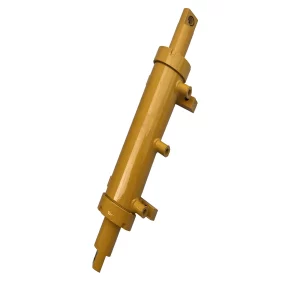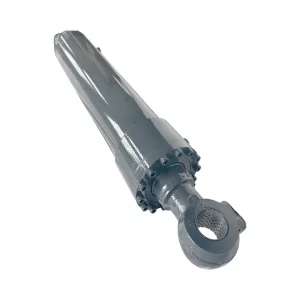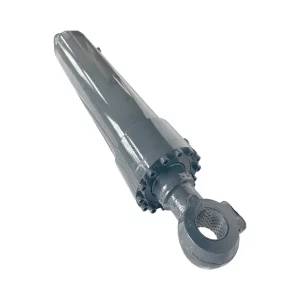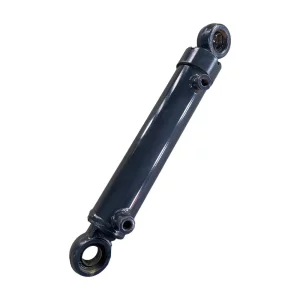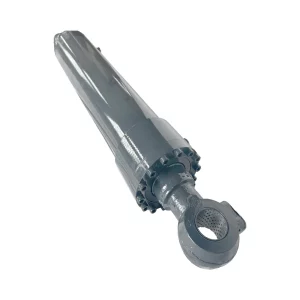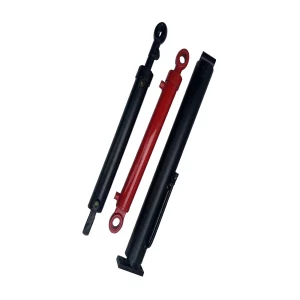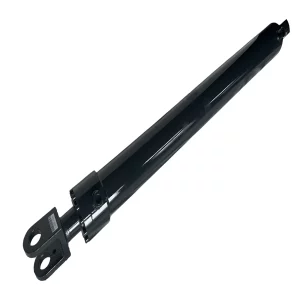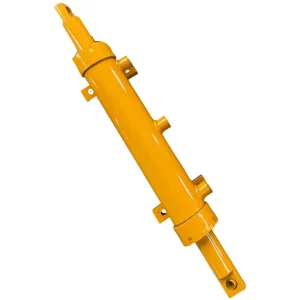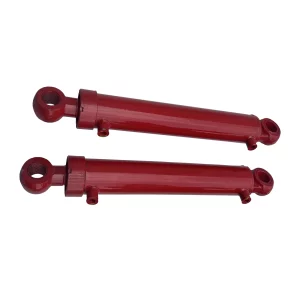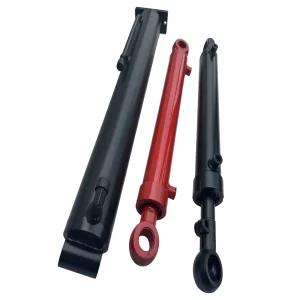Hydraulic Cylinder
A hydraulic cylinder is a mechanical actuator that generates linear force and motion from hydraulic fluid under pressure. It’s a critical component in many types of machinery and systems, widely used in industries such as construction, manufacturing, agriculture, and more. Let’s delve into the details of what a hydraulic cylinder is, how it works, its components, types, and applications.
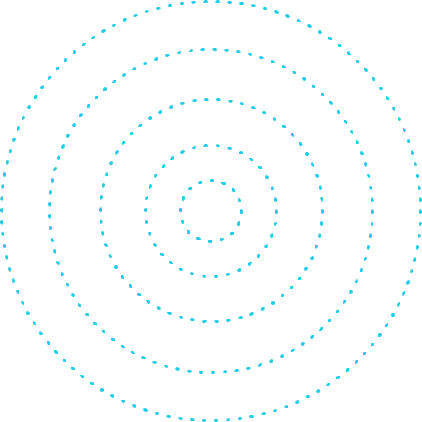

How Does a Hydraulic Cylinder Work?
-
Cylinder Barrel: The main body of the cylinder where the hydraulic fluid is contained.
Piston: A solid disc or short cylinder fitting closely within the barrel and separating the internal space into two chambers. It moves back and forth under fluid pressure.
Piston Rod: Connected to the piston and extends outside the cylinder, transmitting the linear motion and force generated by the piston’s movement.
Cylinder Head and Cap: The ends of the cylinder barrel, sealing the system and containing the hydraulic fluid. They often have ports for fluid to enter and exit.
Seals and Rings: Prevent leakage of hydraulic fluid and contamination of the system.
Features of Hydraulic Cylinder
Hydraulic cylinders are essential components in many mechanical systems, providing the necessary force for a variety of applications. Understanding their features is key to appreciating their functionality and widespread use. Here are some notable features of hydraulic cylinders:


Type of Action
- Single-Acting Cylinders: Fluid enters only one side of the piston, creating movement in a single direction, while a spring or external force returns the piston to its original position.
- Double-Acting Cylinders: Hydraulic fluid can enter through ports at both ends of the cylinder, allowing for control of movement in both directions.
Seals and Bearings:
- Seals: Prevent leakage of hydraulic fluid and maintain internal pressure. They also keep out contaminants.
- Bearings: Located in the gland (head) and on the piston, these guide and support the piston rod and piston, minimizing friction and wear.
Hydraulic Fluid
The fluid transmits the pressure needed to move the piston. It is usually a type of oil with properties that suit the operating environment, such as viscosity and temperature range.
Mounting Options
Hydraulic cylinders come with various mounting options, including flange, clevis, or foot mounting, depending on their intended use and the required level of motion control.
Pressure Rating
Cylinders are designed to operate up to a specific maximum pressure. Exceeding this pressure can damage the cylinder.

Hydraulic Cylinder for Sale
As a hydraulic cylinder manufacturer, we will do our best to serve you. If you need customized products, or the products you need are not found on our website, or need a product catalog, don’t worry, more of our products are still being uploaded. You can email us directly, and we will reply to you within 24 hours!
Showing 1–12 of 25 results
-
America Market Cylinder Hydraulic Piston Export Australia Export Germany Stainless Steel
-
China Hydraulic Lifting Cylinders Stainless Steel Hydraulic Cylinders For Boat Steering High Pressure Hydraulic Cylinder
-
Custom Non-standard Hydraulic Cylinder For Vehicles Multifunctional
-
Customized Adjustable Power Steering Industrial Hydraulic Cylinder Automation
-
Customized Stainless Steel Factory Hydraulic Cylinder Rescue Flatbed Tow Truck Hydraulic Cylinders
-
Double Acting Piston Hydraulic Cylinders For Car Tailgate Mini Stainless Steel Hydraulic Cylinder
-
Export America Export Canada Customized Stainless Steel Hydraulic Cylinders
-
Export Russia Export Peru Export Chile Customized Hydraulic Cylinders Stainless Steel
-
Factory Price Hydraulic Cylinders For Lifting Project Durable Hydraulic Cylinder Stainless Steel
-
Good Service Suppliers Provide High Quality Hydraulic Brake And Clutch Cylinders Multifunctional
-
High Specifications Custom-made Mobile Equipment Hydraulic Cylinder Multifunctional
-
Hydraulic Cylinder For Front End Loader On Farm For Front End Loader Stainless Steel
How to Rebuild a Hydraulic Cylinder
Rebuilding a hydraulic cylinder is a detailed process that involves disassembling, inspecting, cleaning, replacing worn components, and reassembling the cylinder. This process can restore the cylinder’s functionality and extend its life. Here’s a step-by-step guide on how to rebuild a hydraulic cylinder:
Safety and Preparation
- Safety First: Ensure all safety protocols are followed. Wear appropriate protective gear like gloves and goggles.
- Gather Necessary Tools: This may include wrenches, a seal kit, a hydraulic cylinder repair stand, and other specialized tools.
- Clean the Cylinder: Before disassembly, clean the exterior of the cylinder to prevent contamination.
Inspection
- Inspect All Parts: Look for signs of wear, damage, or corrosion on the piston, rod, seals, and barrel.
- Cylinder Barrel: Check for scoring or pitting inside the barrel.
- Piston and Rod: Inspect for damage, wear, or bending.
- Seals and O-rings: Look for cracking or brittleness in the seals.
Reassembly
- Reassemble in Reverse Order: Carefully reassemble the cylinder components in the reverse order of disassembly.
- Ensure Proper Alignment: Misalignment can cause premature wear or damage.
- Torque to Specifications: Tighten any bolts or nuts to the manufacturer’s specified torque settings.
Disassembly
- Release Pressure: Make sure any pressure in the cylinder is released.
- Remove the Cylinder: Detach the cylinder from the machine.
- Disassemble the Cylinder: Carefully remove the end cap, piston rod, piston, and other components. Take note of the order and orientation of each part for reassembly.
Cleaning
- Clean All Components: Use appropriate cleaners to remove all traces of old hydraulic fluid and debris.
- Avoid Abrasive Materials: Do not use abrasive materials that could damage the parts.
Testing
- Test the Cylinder: Once reassembled, reattach the cylinder to the machine and test it under normal operating conditions.
- Check for Leaks: Ensure there are no leaks and that the cylinder operates smoothly.

How to Measure Hydraulic Cylinder
Measuring a hydraulic cylinder accurately is crucial for maintenance, repair, or replacement. Understanding the dimensions of a cylinder helps ensure you select the right replacement parts or new cylinder for your application. Here’s a step-by-step guide on how to measure a hydraulic cylinder:
Safety First
- Release Pressure: Before measuring, ensure that all pressure in the hydraulic system is released.
- Safety Equipment: Wear appropriate safety gear, such as gloves and safety glasses, to protect yourself during the process.
Tools You May Need
- Calipers or a tape measure
- Notepad and pen for recording measurements
- Possibly a camera for taking pictures, which can be helpful for remembering the setup and orientation of parts
★★★★★
Basic Measurements
-
Bore Diameter:
- Precision tools like calipers are preferred for accurate measurements.
- Measure the diameter of the exposed piston rod. The accuracy of this measurement is crucial as it affects the cylinder’s load capacity.
- The stroke length is the distance the piston travels inside the cylinder. Measure from the fully retracted to the fully extended position.
- To measure, mark the position of the rod when fully retracted and then fully extend it to measure the distance between the two points.
-
The bore diameter is the inside diameter of the cylinder barrel. To measure, extend the piston rod fully and measure the diameter of the open end of the barrel.
Rod Diameter:
Stroke Length:
★★★★★
Blog
Hydraulic Cylinder Related Blog
China supplier CZPT Beauty Bed Meidcal Solution Mk5 Hydraulic Actuator Cylinder vacuum pump and compressor
China OEM Wholesale Industrial Hydraulic Cylinder Made in China with Good Price vacuum pump engine
China Custom Cylinders for Trailer and Non Standard Hydraulic Cylinder Customization with Good quality
Address
Bury St Edmunds, Suffolk IP32 7LX, UK
Email Us
Hours
Monday: 11am – 9pm
Tuesday: 11am – 9pm
Wednesday: Closed
Thursday: 11am – 9pm
Friday: 11am – 11pm
Saturday: 11am – 11pm
Sunday: Closed
